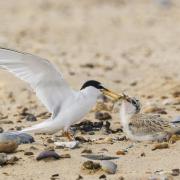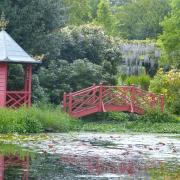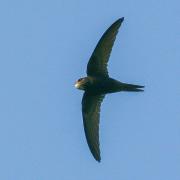Suffolk boasts 5,600km of public rights of way. Why not explore some of them in 2024? Here are a few trails to get you started.

CARLTON MARSHES
Carlton Marshes is in the Waveney Valley, at the southern tip of the Broads National Park, on the Suffolk-Norfolk border. There are 1,000 acres of wildness here; grazing marsh, fens, peat pools, fen meadow, dykes, pools and scrub. Most of it is man-made, habitats that have developed over hundreds of years. It's a wonderful place all year round and in winter the grazing marshes are ideal for wintering wildfowl and breeding waders, home to large numbers of wigeon, teal and snipe. Free entry and parking. Dogs must be on leads. Firm paths accessible to wheelchairs and mobility scooters.
Suffolk Wildlife Trust Carlton Marshes, Burnt Hill Lane, Carlton Colville NR33 8HU

LACKFORD LAKES
There's something to see at Lackford Lakes whatever the time of year from one of the several hides along the short trails. In spring and summer the reserve is alive with swallows and martins, nesting great-crested grebe, kingfishers, tufted ducks and water rail, bees, butterflies, damselflies and dragonflies. Autumn sees the arrival of a wide range of wildfowl which depend on the lakes in winter, including shoveler, lapwing, goosander, bittern and goldeneye. The visitor centre and café is open every day, selling hot and cold drinks, and a variety of cakes and snacks. Free entry. Three trails and eight wildlife viewpoints (maximum one-hour stay).
Suffolk Wildlife Trust Lackford Lakes, Bury St Edmunds IP28 6HX

KNETTISHALL HEATH
Knettishall Heath is more than 430 acres of woodland, riverside meadows and heath, diverse habitats that are home to more than 12,500 species of plants and animals, 30 per cent of which are rare in the UK. It's a fascinating landscape; an 18th century rabbit warren and a Bronze Age burial mound at Hut Hill are evidence of thousands of years of human occupation. There are six short trails around the reserve that are between one and 2.5 miles in length (unsuitable for wheelchairs). Paid parking in the main car park from 10am (contactless machine or RingGo app). Dogs must be on a lead.
Suffolk Wildlife Trust Knettishall Heath, Thetford IP22 2TQ

TRIMLEY MARSHES
After you've parked at the end of Cordy's Lane in Trimley St Mary you have a two-mile walk to the reserve but it's well worth it. Trimley Marshes at the estuary of the River Orwell is a fantastic place to see wildlife all year round. The shallow lagoons and islands provide a variety of habitats throughout the year for, among other, wigeon, teal, Brent geese, redshank and black-tailed godwit, as well as the magnificent marsh harrier. The reedbeds are routinely visited by bittern in winter, joining water rail and reed bunting. The local footpaths enable you to do a six mile circular walk.
Cordy's Lane, Trimley St Mary, Felixstowe IP11 0UD

NOWTON PARK
Nowton Park, just outside Bury St Edmunds, was part of the Oakes family estate purchased in 1832 by Orbell Ray Oakes, son of a prominent Bury banker and diarist. Trees from all around the world grow here and the park is delightful in all seasons. (Note: come back in spring for the daffodil display.) Start at the visitor centre in the car park; there are several waymarked trails that take you to various features in the park, or just go for a stroll wherever your whim takes you. There are good paths so it's suitable for wheelchairs and buggies.
Nowton Park, Bury Rd, Bury Saint Edmunds IP29 5LU

ALDEBURGH
For a coastal winter walk head to Aldeburgh and RSPB North Warren. There are three circuit walks around the marshes which are home to huge numbers of wintering wildfowl, such as wigeon, teal and geese. At dusk you may see marsh harriers and spectacular flocks of starlings coming in to roost in the reedbeds. The South Marsh circuit (4miles/6.5km) starts on the beach; the North Marsh circuit (5.6miles/9km) takes you through wetland, a favourite with white-fronted geese in winter; the Reedbed loop (1.9miles/3km) is easily accessible through woodland and grassland, with a boardwalk section leading to a reedbed viewpoint on the old railway path.
North Warren, Aldeburgh IP15 5BH

DUNWICH
Get away from it all at RSPB Dingle Marshes, near the village of Dunwich. It’s a rich patchwork of habitats, including freshwater reedbed, shingle, coastal marsh, salty lagoons and forest, that attracts a variety of wildlife, including bitterns, marsh harriers. The reedbeds are protected from the sea by a shingle bank, where plants like Sea Kale and Yellow Horned Poppy grow. A circuit trail (4.5miles/7.2km) takes you through reedbeds, home to bitterns, little egrets and redshank among others. Visit the hide located in Dunwich Forest overlooking the reedbed.
RSPB Dingle Marshes, Beach Rd, Saxmundham IP17 3DS

LAVENHAM
The Lavenham Woodland walk (2.8miles/4.5km) is an easy circular walk that's perfect for families. Starting at the Guildhall in Market Place, it takes you to Dyehouse Field, through the Lavenham Woodland community project, along a section of the disused Lavenham to Long Melford railway line, returning via Bridge Street Road – with wonderful views of Lavenham church – then along Lavenham High Stree and up Market Lane, back to the Guildhall. It's a walk rich in the history of Lavenham's medieval wool trade, and in its wildlife; the old railway line is home to many birds, and you're quite likely to see red kites overhead.
Market Place, Lavenham, Sudbury CO10 9QZ




























